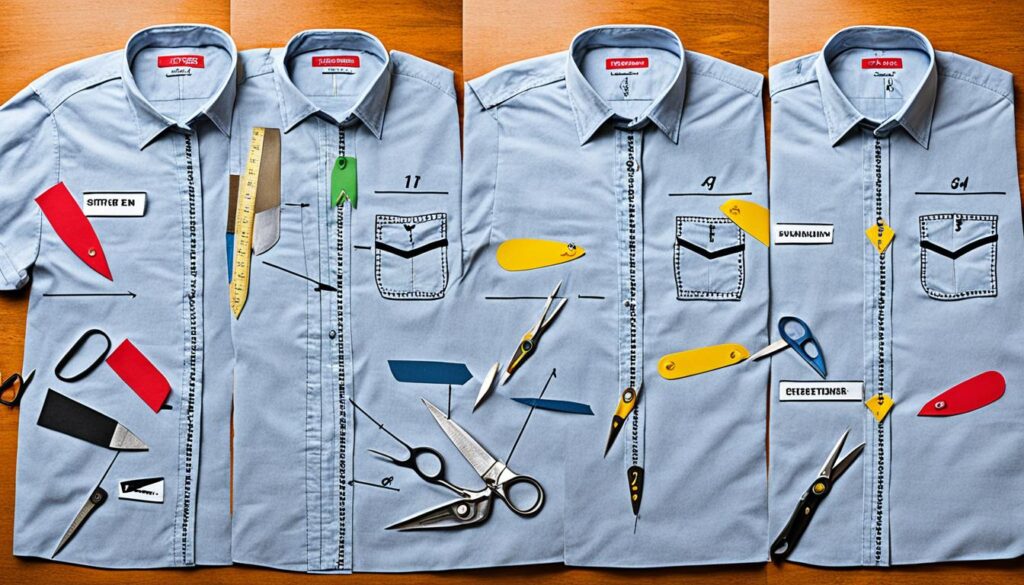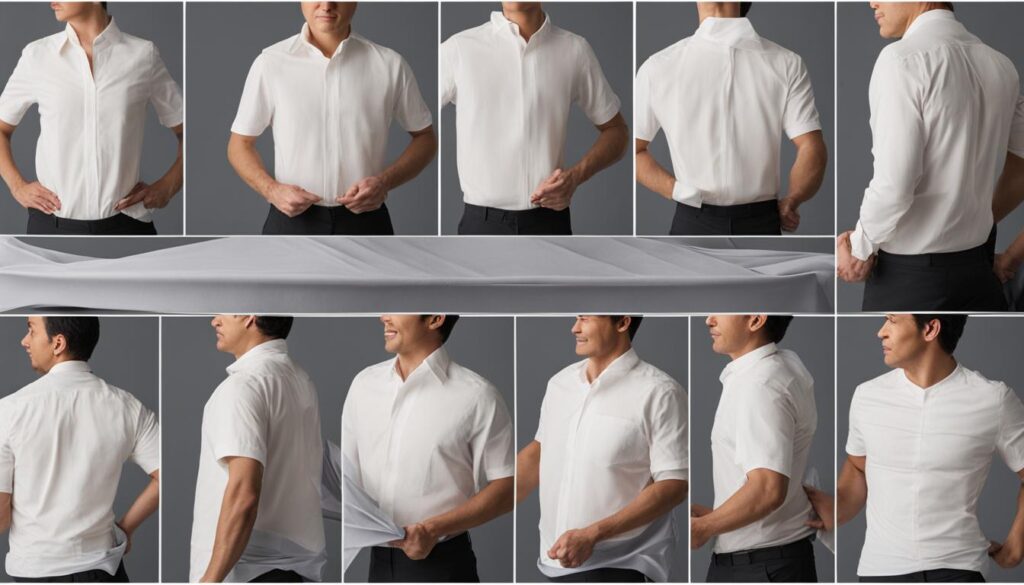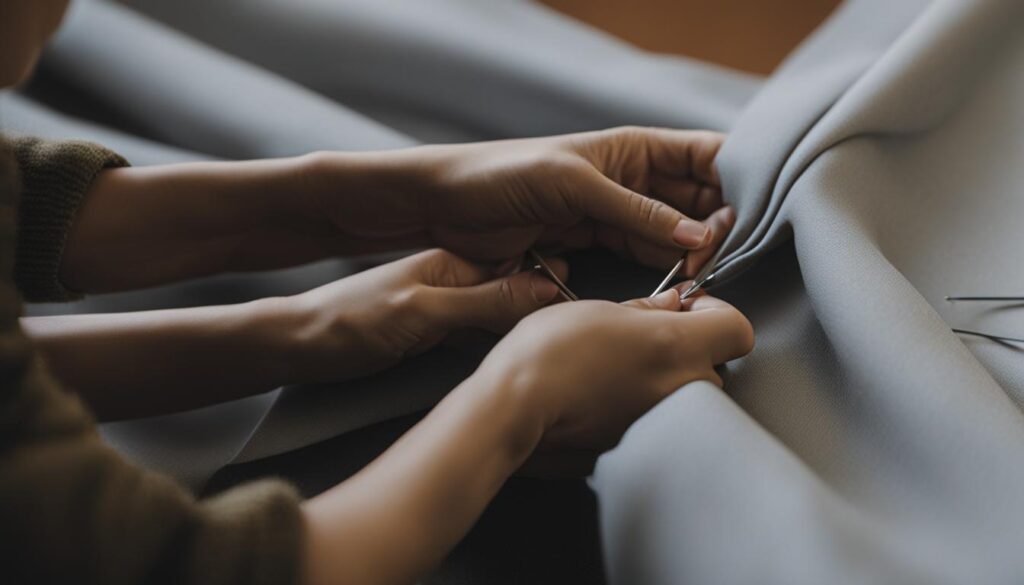Do you have an oversized shirt that you love but wish it fit you better? Perhaps you’ve tried various ways to alter the size of your shirt, only to end up disappointed with the results. Well, fret not! We’re here to reveal the secrets of resizing your shirt to achieve a perfectly tailored fit that accentuates your body shape.
From sewing techniques to shrinking methods, this article will guide you through the process of making a shirt smaller, so you never have to compromise on style and comfort. Say goodbye to ill-fitting shirts and hello to a wardrobe filled with perfectly sized garments that make you look and feel amazing.
Ready to learn how to resize your shirt and unlock a world of styling possibilities? Keep reading to discover the tips and tricks that will transform your oversized shirts into tailored perfection.
Key Takeaways
- Resizing your shirt can lead to a better fit and a more polished appearance.
- There are various methods to make a shirt smaller, including sewing alterations and shrinking techniques.
- It’s essential to choose the right approach based on your preferences and the fabric of the shirt.
- By following step-by-step instructions and using the right tools, you can achieve a perfectly fitting shirt.
- Experimenting with different techniques will help you find the most effective method for resizing your shirts.
Understanding the Importance of Proper Shirt Fit
A well-fitting shirt can make a significant difference in your overall appearance. When a shirt is too big or baggy, it can make you look unkempt or shapeless. On the other hand, a shirt that is too tight can restrict your movement and cause discomfort. It’s essential to find the right balance in shirt fit to enhance your body shape and style. By making the necessary alterations, you can achieve a more flattering and comfortable fit for your shirts.
Proper shirt tailoring tips can help you adjust the shirt fit and modify the shirt size according to your preference. While off-the-rack shirts may not always provide the perfect fit, you can make simple modifications to ensure a tailor-made look. Whether you need to take in the sides, shorten the sleeves, or adjust the shoulder width, understanding the importance of proper fit is essential.
An ill-fitting shirt can distract from an otherwise polished look. By tailoring your shirts to fit your body shape, you can enhance your confidence and present a more put-together appearance. Ready to take your shirt game to the next level? Let’s dive into the methods and techniques that will help you achieve the perfect shirt fit.
How to Make a Shirt Smaller?

Resizing a shirt to achieve a perfect fit doesn’t always require a trip to the tailor. With a few simple DIY methods, you can make your shirt smaller and achieve the desired fit right at home. Whether you are looking to alter the sides, sleeves, or overall size of the shirt, there are various techniques you can try.
Sewing: One of the most popular and effective methods for resizing a shirt is sewing. You can start by taking in the sides of the shirt to create a more fitted look. Trim the excess fabric, ensuring to leave enough seam allowance for sewing. Additionally, you can trim and reattach the sleeves to achieve a better-fitting arm length. Sewing allows you to customize the fit of your shirt to match your body shape.
Shrinking: Another DIY method to make a shirt smaller is shrinking it. Simply wash the shirt in hot water and dry it on high heat in the dryer. The combination of heat and moisture causes the fabric to contract, effectively reducing the overall size of the shirt. However, it’s important to note that this method works best with natural fibers like cotton. Synthetic materials may not shrink as effectively.
Simple Adjustments: If you’re looking for a quick fix or temporary solution, there are simple alterations you can make using everyday materials. Knotting the back of the shirt can create a more gathered or cinched look, instantly reducing the size. Alternatively, you can use safety pins strategically placed on the sides or back of the shirt to create a custom fit that suits your body shape. These adjustments can be easily undone, allowing you to revert to the original size when desired.
Remember, these DIY shirt alterations are suitable for minor adjustments or temporary fixes. For more complex alterations or precise resizing, it’s advisable to consult a professional tailor. Experiment with these DIY methods to resize your shirt at home and enjoy a more flattering and comfortable fit.
Implementing the right DIY methods can help you achieve a perfectly fitting shirt without breaking the bank or sacrificing style. Whether you choose sewing, shrinking, or simple adjustments, resizing your shirt at home is a cost-effective and convenient way to achieve a tailored fit. Try out these clothing resizing techniques and enjoy a wardrobe filled with perfectly fitted shirts.
Steps to Take in a Shirt for a Better Fit
When it comes to achieving a better fit for your shirt, taking the necessary steps to tailor and resize it can make all the difference. Whether you have an oversized shirt that you want to adjust or simply desire a more customized look, follow these simple instructions to achieve a perfectly fitted shirt.
1. Lay your oversized shirt flat: Start by laying your oversized shirt flat on a clean surface. Smooth out any wrinkles and make sure it is evenly spread.
2. Use a well-fitting shirt as a guide: Take a well-fitting shirt that you already own, and place it on top of the oversized shirt. Use it as a guide to determine how much fabric you need to remove.
3. Trim away the excess fabric: With a pair of fabric scissors, carefully trim away the excess fabric on the sides and sleeves of the oversized shirt. Be cautious not to cut too much and leave enough seam allowance for sewing.
4. Cut new sleeves: If you need to adjust the sleeve length, cut new sleeves from the excess fabric you trimmed off earlier. Make sure to leave enough fabric at the cuffs so that they can be reattached.
5. Sew the sleeves back together: Using a sewing machine or needle and thread, sew the newly cut sleeves back together along the edges. Take your time and make sure the stitches are secure and even.
6. Set the sleeves back into the armholes: Carefully set the newly sewn sleeves back into the armholes of the shirt. Align them properly and pin them in place if necessary.
7. Sew up the sides: Start from the bottom of the shirt and sew up the sides, making sure to maintain the desired fit. Double-check the measurements as you sew to ensure evenness and accuracy.
8. Press the seams: Once you have completed the sewing, carefully press the seams with an iron to give your resized shirt a polished and professional look.
9. Try it on: After following all the steps, try on your resized shirt to ensure the fit is exactly how you want it. Make any final adjustments if needed.
Shrinking a Shirt for a Smaller Size

If you prefer a simpler method, you can shrink a shirt to make it smaller. Start by soaking the shirt in hot water for about 30 minutes. Then, wash the shirt in hot water in the washing machine and dry it on high heat in the dryer. This process will cause the fibers of the shirt to contract, resulting in a smaller overall size.
Keep in mind that different fabrics may react differently to shrinking, so it’s essential to consider the fabric type before attempting this method.
Shrinking a shirt is a convenient way to downsize your garment without the need for sewing or alterations. It’s particularly useful for fabrics that have some natural elasticity, such as cotton, that can withstand heat. However, be cautious when using this method on delicate or synthetic fabrics, as they may not respond well to the shrinking process.
Before starting the shrinking process, always check the care label on your shirt to ensure it can withstand hot water and high heat. If the label recommends cold water or air drying, it’s best to avoid this method and consider alternative techniques for resizing your shirt.
Tips for Altering Shirt Size

When it comes to altering the size of a shirt, there are a few key tips to keep in mind. By following these suggestions, you can achieve the perfect fit and ensure that your shirt looks and feels great.
First and foremost, it’s important to start with a well-fitting shirt as a guide for your alterations. This will help you maintain proportion and ensure that the new size matches your desired fit. Use the existing shirt as a template to guide you through the resizing process.
Another tip is to double stitch the seams around the armpits. This strengthens the shirt and prevents any potential rips or tears. The armpit area is prone to stretching, so reinforcing the seams can help maintain the structural integrity of the shirt, especially after alterations.
Additionally, consider wetting the shirt in cold water and stretching it to dry with weights attached. This technique can help reduce the amount of shrinkage that may occur during the resizing process. By carefully stretching the fabric, you can minimize any potential changes in the shirt’s dimensions.
With these tips in mind, you can confidently alter the size of your shirt and achieve a personalized fit that looks and feels amazing. Whether you’re adjusting a shirt for a special occasion or simply tailoring it to suit your style, these techniques will help you create a garment that’s uniquely yours.
When it comes to altering the size of a shirt, these tips will ensure a successful outcome. Remember to work with a well-fitting shirt, reinforce the seams, and consider wetting and stretching the fabric. With these strategies, you’ll have a perfectly sized shirt that suits your individual style.
How to Make a Shirt Smaller Without Sewing and Cutting?
Making a shirt smaller without sewing or cutting can be a bit tricky, but here are some methods you can try:
- Shrink it in the Dryer: Washing and drying your shirt on high heat can cause it to shrink slightly. Keep in mind that this method may not result in a significant reduction in size, and it can also affect the overall fit and shape of the shirt. Additionally, it may not work well for shirts made from certain materials like polyester or pre-shrunk cotton.
- Use Safety Pins or Clips: You can gather excess fabric at the sides of the shirt and secure it with safety pins or clips. Start from the underarm area and gradually work your way down to the hem, creating small folds or gathers. Be careful not to make the shirt too tight or uncomfortable to wear. This method is temporary and may not provide a permanent solution.
- Adjust with Belts or Sashes: For shirts with a looser fit, you can cinch the waist using a belt or sash. Simply wrap the belt or sash around your waist and gather the excess fabric of the shirt underneath it. This can create a more fitted look without altering the shirt permanently.
- Tie it or Tuck it: Another option is to tie or tuck the excess fabric at the waist or sides of the shirt to create a more fitted silhouette. You can experiment with different tying or tucking techniques to achieve the desired look.
- Layer it: If the shirt is significantly larger, you can layer it with a tighter-fitting garment, such as a tank top or fitted long-sleeve shirt. This can help conceal the excess fabric and create a more flattering silhouette.
